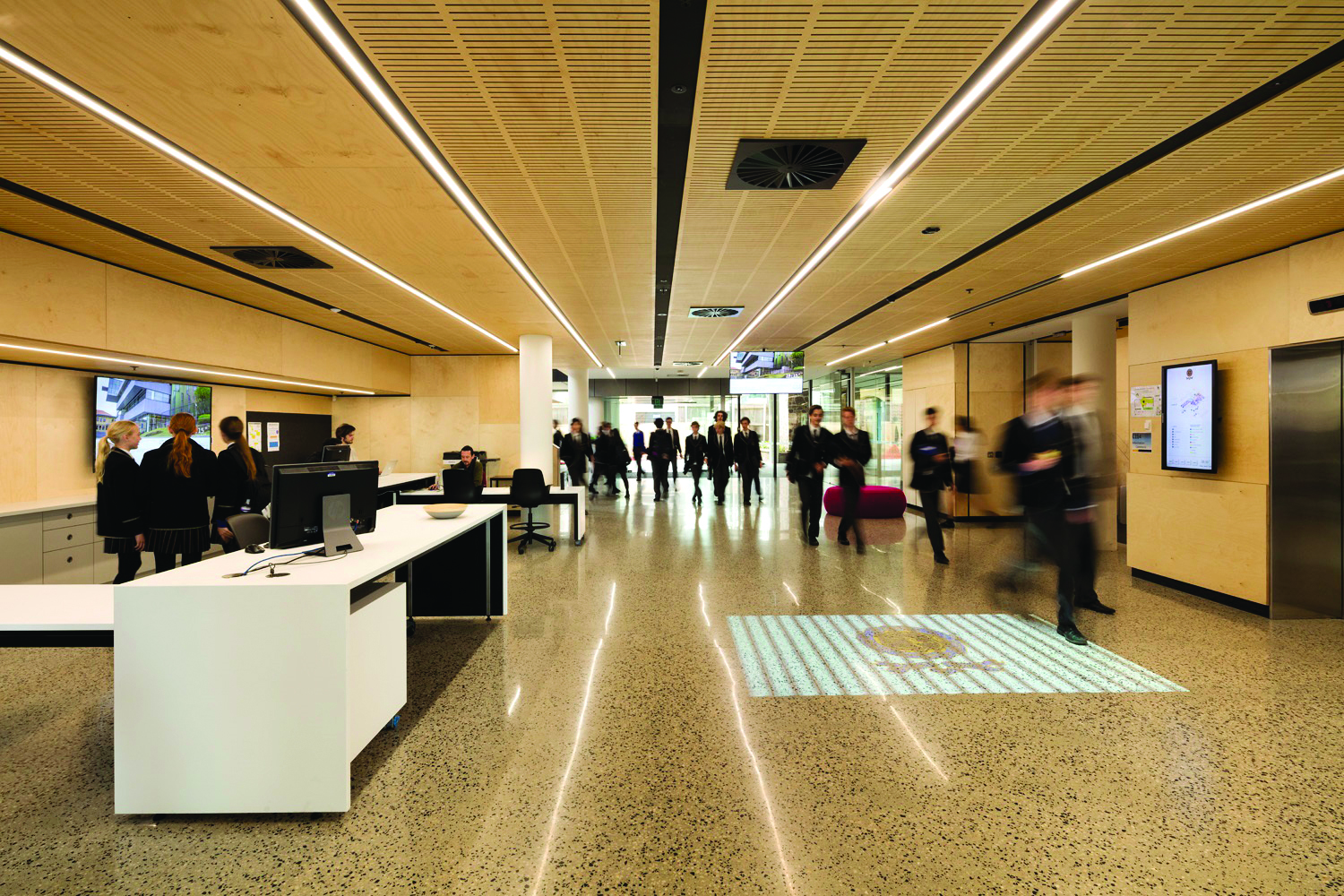Issue 103
Term 4 2017
- Feature article
- Articles
-
- A note from the editor
- Turning the school library into a thriving community hub
- Ten ways to advocate for your role as a teacher librarian
- Celebrating the school library officer
- The School Magazine
- The challenge of implementing change
- Know your rights and responsibilities: teaching digital citizenship
- Regular features
Download this issue
Reimagining the library landscape: an approach to school library design
Carey Baptist Grammar School recently rebuilt their middle and senior library. Anne Whisken outlines her library’s approach to design, ensuring all students’ needs are catered for.
Our new library at Carey Baptist Grammar School, which covers three half-levels at the base of a new Centre for Learning and Innovation, was completed a year ago. Since then, we have arranged our collections to suit the spaces, redesigned our service models, and developed the processes to help our community make best use of our beautiful new library learning spaces. It took about five years of research, design and implementation to reach this stage. This is the story of that journey.

Background: Carey Baptist Grammar School
Carey Baptist Grammar School in Kew, Melbourne, has about 2,400 students from Early Years to Year 12 across two primary schools and a combined middle and senior school.
The libraries
There are two primary school libraries, and a third library is shared by the senior and middle schools. Both VCE and IB are studied at senior levels. All three libraries are regularly refurbished, and their presentations are fresh and inviting. The previous middle–senior library was, however, inadequate for its purpose: a 1970s block design with little room for the flexibility required for evolving ways of teaching and learning. It is this one that has been replaced with our new building.
Library mission
One of Carey’s key goals is to nurture the development of our students to become independent, motivated learners, and the library’s mission is to provide the spaces, programs and resources to support that goal. We view the school library as having a purpose different to that of public and special libraries: its spaces and collections are teaching and learning resources, and its staff and programs support the curricular and co-curricular learning of the school. Its purpose also includes three particular goals: information literacy education, development of study skills, and wide reading promotion. From a library design and facilities management point of view, a secondary school library faces a particular user challenge — that of students in middle school who are bundles of energy and require supervision, and senior students who, while rather more lethargic and requiring less supervision, still need help in transitioning from younger teen behaviour to older, more tertiary-oriented individual and group study behaviours.
Library design process
The school wished to upgrade to an exciting library learning space that would sit with eLearning and ICT support at the heart of a multi-level Centre for Learning and Innovation. Library staff were invited to become design partners with other key stakeholders and the architects. Several years of research were undertaken as the design brief was developed, with Scoop-It (Library Learning Spaces 2017) used to curate international and national designs for state, public, special, and education libraries.
Our library team visited many different school, public, and tertiary libraries to gather ideas. We looked at the attitudes required for successful design collaboration with stakeholders holding very different expectations about the programs and functions of new library spaces (Sherwin 2015, Shipp 2015). Note was taken of how new library buildings might support a blend of new and traditional functions (Weir 2015, Vaultier 2015, Anderson 2016, Letting in the light 2015, Cuthbertson 2015, Conyer 2015) and we researched the ways retailers were evolving their space and service models and how product was presented to clientele (Whisken 2016).
We kept the idea of libraries as learning spaces at the front of our thinking, ever asking: how might this space design and furniture/collection configuration assist the particular experiences of learning, either with information (Bruce 2008) or with fiction, that we want to take place? For example, how might the physicality of library spaces support guided inquiry (Sullivan 2015)? We incorporated ideas about iCentres (Hay 2011a, Hay 2011b, Hay 2012) and participatory co-design (Hughes 2015) into our thinking.
Research about our collection arrangement was also pivotal to the design process. We had experimented with ‘collectionising’ our non-fiction and ‘genrefying’ our fiction in the old library, and with presenting the collection on wall shelves instead of the traditional double-sided stack arrangement. This reflected retail bookshop practice, and was the outcome of (often heated) library team discussions about ways to best present book collections for interaction by users. It was decided that our nonfiction collection arrangements should reflect the way the subjects were taught at the school, and that the fiction collections should reflect our wide reading program’s genre approach so that students might independently browse in interest areas. Accordingly, we were able to agree with what was also an architectural preference to depart from traditional library collection arrangements.
The result

The fireside lounge provides a space for students to converse in small groups.
We designed the library space to recognise that we are physical and social beings, and that, while we use other means to facilitate the digitally located learning that takes place at our school, we must also provide the best possible physical spaces for the learning with resources that libraries facilitate. David Thornburg’s Campfires in Cyberspace (2004) was one of the structures we used for conversations with the architects. It worked as well for describing physical spaces as for digital spaces, and the architects were familiar with the concepts so we had a common language. We said we wanted the following features.
‘Watering holes’
These are the spaces that most people visit at some stage of the day, so they provide for the fast social interactions that enable sharing and networking and access to key resources. These became the ICT Desk; the eLearning Sandpit; and the library’s Lobby Lounge, Café, and Helpzone. These are located together in or at the side of the Information Commons — a traffic concourse linking middle and secondary school learning spaces.
‘Campfires’
Campfires are the smaller, focal spaces for small and large groups to sit around and ‘chew the fat’ (lessons, group work, etc) together. These materialised in the library as: two research classrooms with formal tables and chairs; two wide-reading rooms with low lounge chairs and beanbags; five seminar rooms, each with central table and chairs; a Harkness room with huge oval table and 18 chairs; a fireside lounge; a variety of tall and low benches and stools; and four- and two-person table and chair formations spread across three levels.
‘Caves’
Caves, where individuals reflect and create, are integral to the concentration required for embedding knowledge and generating new ideas. These became the 30 single carrels located deep in the quietest place in the library, where silent study is expected and maintained and there is no mobile phone reach.
‘Mountain tops’
Mountain tops provide larger presentation spaces for sharing and celebrating new knowledge and creative achievements. These became stepped seating in the two-level library hall, providing 40 places and a large screen; and digital screens that promote and celebrate library programs and student achievement throughout the library and Information Commons.
The library in use
Most of the spaces in the library have bookshelves wrapped around their walls so that the students are constantly surrounded by the book resources they use, with visual prompts to the catalogue, online databases, and ebooks. All furniture, apart from that in the reading rooms and fireside lounge, consists of tables and chairs for proper use of laptops. Students prefer that — there has to be space for water bottle, laptop, mobile phone and earphones, pens and paper. Chairs and tables say ‘work’ to students; a couch or divan says ‘relax’; and most students like good back support whatever they are doing.
These spaces run over three cantilevered levels, so we have different noise expectations, with a fair bit of loudness on the top two levels, and either total silence or very quiet conversation on the bottom level where the senior study and wide reading occurs. Most popular with the students are the silent/quiet areas for seniors and the ‘beanbag’ rooms for middle school students, with the fireside lounge and high bench areas that overlook the oval commonly used by all students. And, of course, the ICT Sandpit with fabulous interactive eLearning technology attracts a particular cohort.
Supervision of these spaces, over three levels, with opening hours 7.30 am to 6.00 pm, presents particular challenges, and we are working this out as we go. The move to self-loan kiosks helps, as does a system in which senior students ‘borrow’ via the library system any seminar rooms they use. These two procedures assist students to take responsibility both for their loans and for the proper use of spaces.
We have achieved our intention. The design of the new building’s library learning spaces guides students’ independent choice of those spaces that best suit their learning purpose.
References
- Anderson C 2016, ‘Transforming RMIT’s Swanston Library’, INCITE, January/February, 20–21
- Bruce C 2008, Informed Learning, CUP, Chicago
- Conyer B 2015, ‘Codesigning: the future of the State Library of Victoria’, INCITE, September, 21
- Cuthbertson D 2015, ‘Is this the world’s wildest library? The Age 9 Nov 2015, accessed 14 April 2016, http://www.smh.com.au/entertainment/art-and-design/is-this-the-worlds-wildest-library-geelongs-45-million-big-brain-about-to-open-up-to-the-world-20151109-gkue6r.html#ixzz463VRDV6A
- Hay L 2011a, ‘The What, Why, Who and How of Building an iCentre, Part 1’, accessed 24 October 2012: http://www.slideshare.net/lhay/hay-build-anicentrept1june2011slides
- Hay L 2011b, ‘The What, Why, Who and How of Building an iCentre, Part 2’, accessed 24 October 2012, http://www.slideshare.net/lhay/hay-buildanicentrept2aug2011
- Hay L 2012, ‘ What Is an iCentre?’, Student Learning Through School Libraries, accessed 6 October 2012, http://studentslearn.wordpress.com/about/about-icentres/
- Hughes H 2015, ‘Participatory library designing’, FYI, 19(2), 4–6, 1
- ‘Letting in the light’ 2015 INCITE, November/December, 18–19
- Library Learning Spaces 2017, accessed 9 August 2017, http://www.scoop.it/t/library-learning-spaces
- Sherwin K 2015, ‘Future libraries: what could they be?’ INCITE, September, 14–15.
- Shipp J 2015, ‘The sage on form and function’, INCITE, November/December, 10–11
- Sullivan M 2015, ‘Space as a stimulus for learning’, Synergy, 13(1), accessed 14 April 2016, http://www.slav.vic.edu.au/synergy/volume-13-number-1-2015.html
- Vaultier L 2015, ‘That’s why you’re an architect and I’m a librarian’, INCITE, November/December, 16
- Thornburg D 2004, ‘Campfires in Cyberspace: primordial metaphors for learning in the 21st century’, International Journal of Instructional Technology and Distance Learning, 1(10), accessed 2 April 2014, http://69.36.77.223/Journal/Oct_04/Oct_04.pdf#page=7
- Whisken A 2016, ‘Learning Landscapes: successful library design attitudes’, Synergy, 14(1), accessed 5 Sept 2016, http://www.slav.vic.edu.au/synergy/volume-14-number-1-2016.html
